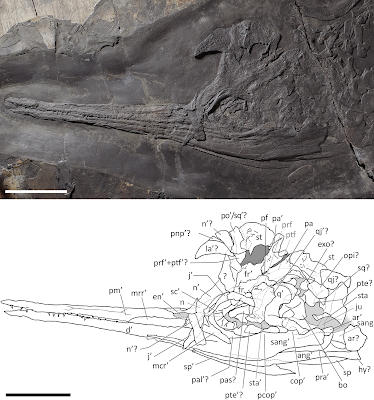 |
| Besanosaurus leptorhynchus Dal Sasso & Pinna, 1996 in Bindellini, Wolniewicz, ... et Dal Sasso, 2021. |
Abstract
Besanosaurus leptorhynchus Dal Sasso & Pinna, 1996 was described on the basis of a single fossil excavated near Besano (Italy) nearly three decades ago. Here, we re-examine its cranial osteology and assign five additional specimens to B. leptorhynchus, four of which were so far undescribed. All of the referred specimens were collected from the Middle Triassic outcrops of the Monte San Giorgio area (Italy/Switzerland) and are housed in various museum collections in Europe. The revised diagnosis of the taxon includes the following combination of cranial characters: extreme longirostry; an elongate frontal not participating in the supratemporal fenestra; a prominent ‘triangular process’ of the quadrate; a caudoventral exposure of the postorbital on the skull roof; a prominent coronoid (preglenoid) process of the surangular; tiny conical teeth with coarsely-striated crown surfaces and deeply-grooved roots; mesial maxillary teeth set in sockets; distal maxillary teeth set in a short groove. All these characters are shared with the holotype of Mikadocephalus gracilirostris Maisch & Matzke, 1997, which we consider as a junior synonym of B. leptorhynchus. An updated phylogenetic analysis, which includes revised scores for B. leptorhynchus and several other shastasaurids, recovers B. leptorhynchus as a basal merriamosaurian, but it is unclear if Shastasauridae form a clade, or represent a paraphyletic group. The inferred body length of the examined specimens ranges from 1 m to about 8 m. The extreme longirostry suggests that B. leptorhynchus primarily fed on small and elusive prey, feeding lower in the food web than an apex predator: a novel ecological specialisation never reported before the Anisian in a large diapsid. This specialization might have triggered an increase of body size and helped to maintain low competition among the diverse ichthyosaur fauna of the Besano Formation.
 |
| Figure 3: The most complete skeletons of Besanosaurus leptorhynchus. (A) PIMUZ T 1895; (B) BES SC 999; (C) PIMUZ T 4376 (with a Mixosaurus specimen above it); (D) PIMUZ T 4847. Scale bars represent 50 cm. |
Besanosaurus leptorhynchus Dal Sasso & Pinna, 1996
Conclusions:
In general, the specimens here described preserve and represent a remarkably complete cranial anatomy, so that Besanosaurus leptorhynchus now is among the best-understood Middle Triassic Ichthyosaur taxa to date. Our revision of the skull morphology of this taxon clarified long-standing controversies regarding its cranial anatomy and the taxonomy of shastasaurids from Monte San Giorgio. Based on this rich fossil material, we have demonstrated that Mikadocephalus gracilirostris (GPIT 1793/1) is a junior synonym of Besanosaurus leptorhynchus, providing evidence to refute previous hypotheses (Maisch & Matzke, 1997a, 2000; Maisch, 2010) about the co-occurrence of two different shastasaurid taxa (Besanosaurus and Mikadocephalus) in the Besano Formation.
The six specimens here described represent a potential ontogenetic series covering a certain size range of mainly adult and potentially subadult specimens (Fig. 19), ordered by increasing size as follows: PIMUZ T 4376, PIMUZ T 1895, BES SC 999, BES SC 1016, GPIT 1793/1, PIMUZ T 4847. An allometric growth signal, yet to be fully tested, has also been detected. Other sources of intraspecific variation such as sexual dimorphism, cannot be ruled out, however, partly due to the limited dataset. Here we also report evidence that Besanosaurus was the largest Middle Triassic ichthyosaur taxon of the Western Tethys since we confidently estimate a fully adult size of about 8 m for specimen PIMUZ T 4847.
Besanosaurus possesses an extremely long, slender, and gracile snout, representing an ecological specialization never seen before the Anisian in a large sized (~8 m) diapsid. The diagnostic, prominent coronoid (preglenoid) process of the surangular and a large rugose area for the attachment of the mAMES allow to infer the presence of well-developed jaw closing muscles, which likely had an important functional role: we assume an efficient and fast jaw closing movement and hypothesize a snap-feeder-like hunting strategy, with a specific preference for small and elusive prey (such as coleoids and/or small fishes). Among the ichthyosaurian Besano-Monte San Giorgio Fauna (Cymbopondylus, mixosaurids, and Besanosaurus), different hunting strategies, demonstrated by different morphologies and dimensions of the rostra, should have led to the maintenance of low interspecific competition (i.e., niche partitioning). We also hypothesize that the specialization represented by a longirostrine morphology might have been driven by prey preference and the methods of prey capture. Mixosaurus and Cymbospondylus show almost a global distribution; on the contrary, Besanosaurus is known only from the Besano Formation (Italy and Switzerland). A wider distribution of this genus is expected (and supported by McGowan & Motani, 2003: 135–136): it seems unlikely to us that Besanosaurus would be represented only in the Alpine Tethys realm.
Last but not least, the importance of Besanosaurus is not only given by the completeness and remarkable preservation of its remains, and its ecological role, but also by the key phylogenetic position occupied by the taxon in the ichthyosaurian phylogeny: our analysis, performed with a matrix that includes around 90% of unambiguous scores for B. leptorhynchus and revised scores for other Triassic taxa, shows that this taxon represents the basalmost member of shastasaur-grade ichthyosaurs.
Gabriele Bindellini, Andrzej S. Wolniewicz, Feiko Miedema, Torsten M. Scheyer and Cristiano Dal Sasso. 2021. Cranial Anatomy of Besanosaurus leptorhynchus Dal Sasso & Pinna, 1996 (Reptilia: Ichthyosauria) from the Middle Triassic Besano Formation of Monte San Giorgio, Italy/Switzerland: Taxonomic and Palaeobiological Implications. PeerJ. 9:e11179. DOI: 10.7717/peerj.11179




